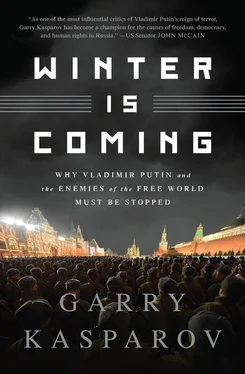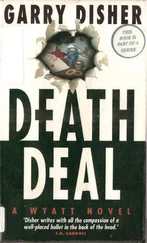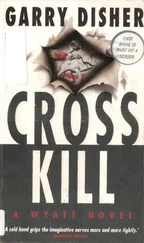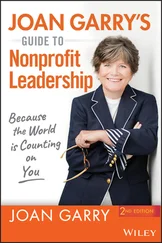It is very dangerous to believe that the fall of a symbol is the same as the end of what that symbol represented, but the temptation to do so is nearly irresistible. People have a strong affinity for symbols and narratives of all kinds, especially when they look like the happy ending of a long and dark fairy tale. The Berlin Wall was a literal and figurative division of the world into good and evil, light and darkness. When ecstatic Germans poured across the fortified border and took hammers to the hated Wall, it was easy to believe that evil itself had been defeated.
Celebration was warranted, of course. Hundreds of millions of people were waking from a totalitarian nightmare that had lasted for decades. The “Evil Empire” had fallen. A span of over sixty-seven hundred kilometers—a quarter of the globe, reaching from the Chukotka Peninsula in the Russian Far East to Berlin—escaped from Communist repression and economic blight to the bright hope of democracy and free markets nearly overnight. It was a glorious, unforgettable moment.
There were also more practical reasons to celebrate. The existential threat of nuclear war was lifted. Three generations had grown up with duck-and-cover drills and dinner table talk of “mutually assured destruction.” Countless billions of dollars had been invested in military measures and countermeasures that were now going to become redundant. The resulting “peace dividend” was going to lead to a new era of prosperity, or so the widely accepted storyline went.
I have written about what I call “the gravity of past success” in chess. Each victory pulls the victor down slightly and makes it harder to put in maximum effort to improve further. Meanwhile, the loser knows that he made a mistake, that something went wrong, and he will work hard to improve for next time. The happy winner often assumes he won simply because he is great. Typically, however, the winner is just the player who made the next-to-last mistake. It takes tremendous discipline to overcome this tendency and to learn lessons from a victory.
The natural response, the human response, in the aftermath of winning the Cold War was to embrace the former enemy. Clinton and Yeltsin hugged and laughed. The European Union and NATO welcomed the former Soviet Bloc nations with open arms and invested billions of dollars to aid the newcomers. When it came to economic and political reform, the sticks of isolation and containment were dropped in favor of a purely carrot-based Western policy. The EU and other institutions offered the newly free countries incentives to join as full partners if minimum conditions of political transparency and economic reforms were met. This principle of engagement was a great success in Eastern Europe, despite the bumpy road for many.
But this expansive method was also applied in places where the forces of oppression had not been rooted out. Countries where Soviet-style repression had merely been renamed were invited into the club with few demands, and little reciprocity. The prevailing attitude in the West was “It’s okay, they will come around eventually. Democracy has won, the bad guys are on the wrong side of history. We just have to keep engaging with them and wait.” But the proverbial forces of history do not win wars on their own. And experience has shown that you can often do just fine being on the wrong side of history if you are on the right side of a pipeline.
In hindsight it is amazing how quickly the lessons of the Cold War victory were forgotten and abandoned. At the moment of greatest ascendancy of the forces of freedom and democracy in history, the West stopped pressing the advantage. With overwhelming military, economic, and moral power on its side, the West changed strategies entirely.
In today’s era of globalization and false equivalence it can be hard for many of us to recall that most Cold War leaders had seen true evil up close during World War II. They had no illusions about what dictators were capable of if given the chance. They had witnessed existential threats with their own eyes and seen the horrors of the concentration camps. They also knew that nuclear weapons could be used in war; for generations that followed, that thought was almost literally inconceivable. It is a shame that today Adolf Hitler and Joseph Stalin have become caricatures, as if they are mythological beasts representing an ancient evil vanquished long ago.
But evil does not die, just as history does not end. Like a weed, evil can be cut back but never entirely uprooted. It waits for its chance to spread through the cracks in our vigilance. It can take root in the fertile soil of our complacency, or even the rocky rubble of the fallen Berlin Wall.
Communism did not disappear when the Wall came down. Nearly 1.5 billion human beings still live in Communist dictatorships today, and another billion and a half live in unfree states of different stripes, including, of course, much of the former Soviet Union. The desire of men to exploit and to rule over others by diktat, and by force, did not disappear when the Wall fell. What did disappear—or, at least, what faded dramatically—was the willingness of the free world to take a firm stand in support of the oppressed.
This shift is understandable, as it represented the public’s desire to end decades of tension and standoffs. Bill Clinton, who took office in 1992, was the first baby boomer president, and he epitomized the mindset that it was time to move beyond the harsh Manichean worldview of the Cold War. Meanwhile, the dragon’s teeth were growing. Belorussian dictator Lukashenko began his lifetime tenure in 1994. His Central Asian dictator colleagues, Nazarbayev of Kazakhstan and Karimov of Uzbekistan, have been in power for over a quarter century. It is no coincidence that two of the countries from the former Soviet Union with the greatest potential to break free of Russia’s dire gravitational pull, Georgia and Ukraine, have both been attacked by Russia and partially occupied.
It is true these thugs and autocrats do not represent a threat to the global order anywhere near that posed by the Soviet Union, despite Putin’s attempts to cobble together a “USSR-lite” via trade agreements, intimidation, and puppet leaders. Beyond its military capability, the USSR was a threat because it aggressively propounded a toxic ideology, Communism, which was capable of spreading far beyond its borders. Until recently, Putin has felt capable of looting Russia and consolidating power without resorting to anything resembling ideology. “Let’s steal together” has been his ruling elite’s only motto, using government power to move money into the pockets of those wielding that power. But as the economic situation in Russia has deteriorated, Putin has been obliged to turn to the later chapters in the dictator’s handbook to find new ways to justify his role as the supreme leader.
Since 2013, the Kremlin and its various mouthpieces have accompanied the latest crackdowns on gays and the media with overtly fascist rhetoric about “un-Russian” behavior, treason, and betrayal of the nation. Some of these speeches, including a few of Putin’s own, so closely resemble those of Nazi leaders in the 1930s that they seem only to change the word “fatherland” to “motherland.” But as Hitler knew, you eventually run out of internal enemies and have to look abroad. The demonization of the United States in state-run media had been going on for a decade, but it wasn’t enough.
When Putin’s puppet president in Ukraine, Viktor Yanukovych, fled the country after the “Euromaidan” protests demanding greater European integration, Putin seized his chance. Citing the need to protect Russians in Ukraine, he first occupied and annexed Crimea and then began inciting violence via Russian-supported “rebels” in Eastern Ukraine. Soon after, despite the Kremlin’s increasingly absurd claims to the contrary, Russian troops and heavy arms turned the conflict into an actual invasion.
Читать дальше













